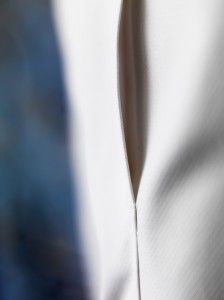
Most of our longer lab coats feature traditional side slits, or side vents, and recently I wondered why. From a historical standpoint, double side slits made their first appearance in British tailored suit jackets. In a suit jacket, these vents take the form of flap-like slits in the back bottom of the jacket. Originally, these vents were designed as a sporting option, enabling the wearer to more easily ride a horse. For this reason, they became standard in hunting jackets before becoming a staple feature of most men's suit jackets. Today, suit jackets are available in double-vented, single-vented, and vent-less styles. The latter is rare and associated primarily with highly formal Italian suits, while the single vent is a popular and more casual American style. The double vented style has maintained its British roots, and is considered an ideal option for improving the hang of a suit jacket while sitting down or when accessing pant pockets. Never before has the Medelita motto 'Your lab coat is your suit' been more relevant than in the realization that this traditional lab coat feature was adopted and refined from the suit jackets of the past. Although I don't imagine that many people hunt or ride horses in their lab coats, side vents are still a popular and relevant feature of unisex or men's lab coats. Vents on lab coats evolved to sit along the side seam, allowing easy access to the pant pockets beneath while the coat is closed. This makes sense for men, whose pockets are generally aligned with pant seams, but for women, pocket placement is different and pockets often sit more towards the front of pants to reduce the bulk of a female silhouette. Additionally, a trend towards wearing a lab coat open seems to be growing. Interestingly, our dental lab coats do not have side slits. During our design stages, we interviewed hundreds of dentists, and the overwhelming majority didn't want them. These facts, combined with the knowledge that there are more pockets built into lab coats today than ever before, begs the question, "Are side slits a functional feature for women?" According to a Physician Assistant that recently wrote to us, the answer is no. "I discussed the importance of side slits with some colleagues. We do not feel that they would be missed," she told us. We'd love to hear from more of our colleagues on the topic of side vents. What is your opinion of this traditional (but perhaps outdated) feature?